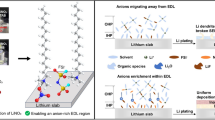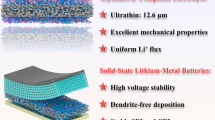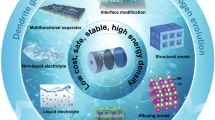Abstract
Rechargeable aqueous alkaline zinc batteries (AZBs) have received extensive attention due to their cost-effectiveness and environmental friendliness. However, the areal capacity of currently reported AZBs is still unsatisfactory especially at high mass loading, which hinders their further practical application. Herein, we propose a simple precipitate strategy to prepare low-cost Bi2O2CO3 nanoflakes for AZBs. The resultant Bi2O2CO3 undergoes a structural transformation during the charge/discharge cycle, which not only significantly changed the microstructure but also optimized the energy storage capability of the as-prepared material. At a high mass loading of 30 mg cm−2, the as-fabricated electrode could attain a high areal capacity of 5.14 mAh cm−2 at the current density of 15 mA cm−2, excellent rate capability (2.40 mAh cm−2 at 180 mA cm−2), and long cycling life of about 88.6% retention after 800 charge/discharge cycles. Ex situ XRD and SEM techniques show that the energy storage mechanism of the prepared material is predominantly contributed by the reversible conversion reaction between Bi and Bi2O3 in the KOH aqueous electrolyte. This work might shed light on the construction of advanced materials in alkaline energy-storage devices.





Similar content being viewed by others
References
Zhang N, Chen X, Yu M, Niu Z, Cheng F, Chen J (2020) Materials chemistry for rechargeable zinc-ion batteries. Chem Soc Rev 49:4203. https://doi.org/10.1039/C9CS00349E
Wang Y, Xie J, Luo J, Yu Y, Liu X, Lu X (2022) Methods for rational design of advanced Zn-based batteries. Small Methods 6:2200560. https://doi.org/10.1002/smtd.202200560
Chao D, Zhou W, Xie F, Ye C, Li H, Jaroniec M, Qiao SZ (2020) Roadmap for advanced aqueous batteries: from design of materials to applications. Sci Adv 6:eaba4098. https://doi.org/10.1126/sciadv.aba4098
Liu J, Bao Z, Cui Y, Dufek EJ, Goodenough JB, Khalifah P, Li Q, Liaw BY, Liu P, Manthiram A, Meng YS, Subramanian VR, Toney MF, Viswanathan VV, Whittingham MS, Xiao J, Xu W, Yang J, Yang XQ, Zhang JG (2019) Pathways for practical high-energy long-cycling lithium metal batteries. Nat Energy 4:180. https://doi.org/10.1038/s41560-019-0338-x
Li W, Dolocan A, Oh P, Celio H, Park S, Cho J, Manthiram A (2017) Dynamic behaviour of interphases and its implication on high-energy-density cathode materials in lithium-ion batteries. Nat Commun 8:14589. https://doi.org/10.1038/ncomms14589
Weidenkaff A, Wagner-Wenz R, Veziridis A (2021) A world without electronic waste. Nat Rev Mater 6:462. https://doi.org/10.1038/s41578-021-00330-y
Chen M, Ma X, Chen B, Arsenault R, Karlson P, Simon N, Wang Y (2019) Recycling end-of-life electric vehicle lithium-ion batteries. Joule 3:2622. https://doi.org/10.1016/j.joule.2019.09.014
Parker JF, Chervin CN, Pala IR, Machler M, Burz MF, Long JW, Rolison DR (2017) Rechargeable nickel–3D zinc batteries: an energy-dense, safer alternative to lithium-ion. Science 356:415. https://doi.org/10.1126/science.aak9991
Zhou W, Zhu D, He J, Li J, Chen H, Chen Y, Chao D (2020) A scalable top-down strategy toward practical metrics of Ni–Zn aqueous batteries with total energy densities of 165 W h kg−1 and 506 W h L−1. Energ Environ Sci 13:4157. https://doi.org/10.1039/D0EE01221A
Sun W, Wang F, Zhang B, Zhang M, Küpers V, Ji X, Theile C, Bieker P, Xu K, Wang C, Winter M (2021) A rechargeable zinc-air battery based on zinc peroxide chemistry. Science 371:46. https://doi.org/10.1126/science.abb9554
Liang P, Yi J, Liu X, Wu K, Wang Z, Cui J, Liu Y, Wang Y, Xia Y, Zhang J (2020) Highly reversible Zn anode enabled by controllable formation of nucleation sites for Zn-based batteries. Adv Funct Mater 30:1908528. https://doi.org/10.1002/adfm.201908528
Zhou L, Yang F, Zeng S, Gao X, Liu X, Cao X, Yu P, Lu X (2022) Zincophilic Cu sites induce dendrite-free Zn anodes for robust alkaline/neutral aqueous batteries. Adv Funct Mater 32:2110829. https://doi.org/10.1002/adfm.202110829
Xie Y, Fei B, Cai D, Chen Q, Cui Z, Wang Q, Zhan H (2020) Multicomponent hierarchical NiCo2O4@ CoMoO4@ Co3O4 arrayed structures for high areal energy density aqueous NiCo//Zn batteries. Energy Storage Mater 31:27. https://doi.org/10.1016/j.ensm.2020.05.024
Wang X, Li M, Wang Y, Chen B, Zhu Y, Wu Y (2015) A Zn–NiO rechargeable battery with long lifespan and high energy density. J Mater Chem A 3:8280. https://doi.org/10.1039/c5ta01947h
Wong CPP, Lai CW, Lee KM, Pan GT, Huang CM, Juan JC, Yang TCK (2022) Enhancement of discharge capacity and energy density by oxygen vacancies in nickel doped SrTiO3 as cathode for rechargeable alkaline zinc battery. Electrochim Acta 404:139705. https://doi.org/10.1016/j.electacta.2021.139705
Zeng Y, Lai Z, Han Y, Zhang H, Xie S, Lu X (2018) Oxygen-vacancy and surface modulation of ultrathin nickel cobaltite nanosheets as a high-energy cathode for advanced Zn-ion batteries. Adv Mater 30:1802396. https://doi.org/10.1002/adma.201802396
Wang D, Zhao Y, Liang G, Mo F, Li H, Huang Z, Li X, Tang T, Dong B, Zhi C (2020) A zinc battery with ultra-flat discharge plateau through phase transition mechanism. Nano Energy 71:104583. https://doi.org/10.1016/j.nanoen.2020.104583
Xie J, Zhang H, Yang F, Cao X, Liu X, Lu X (2022) Iron decorated ultrathin cobaltous hydroxide nanoflakes with impressive electrochemical reactivity for aqueous Zn batteries. Chem Commun 58:3977. https://doi.org/10.1039/d2cc00475e
Khodayar N, Noori A, Rahmanifar MS, Shabangoli Y, Baghervand A, El-Kady MF, Hassani N, Chang X, Neek-Amal M, Kaner RB (2022) Super-fast and super-long-life rechargeable zinc battery. Adv Energy Mater 12:2202784. https://doi.org/10.1002/aenm.202202784
Shi W, Mao J, Xu X, Liu W, Zhang L, Cao X, Lu X (2019) An ultra-dense NiS 2/reduced graphene oxide composite cathode for high-volumetric/gravimetric energy density nickel–zinc batteries. J Mater Chem A 7:21678. https://doi.org/10.1039/C9TA08625K
Wang X, Yang Z, Zhang P, He Y, Qiao Z-A, Zhai X, Huang H (2021) Ni (OH) 2 cathode with oxygen vacancies induced from electroxidizing Ni3S2 nanosheets for aqueous rechargeable Ni–Zn battery. J Alloys Compd 855:157488. https://doi.org/10.1016/j.jallcom.2020.157488
Yu J, Cai D, Si J, Zhan H, Wang Q (2022) MOF-derived NiCo2S4 and carbon hybrid hollow spheres compactly concatenated by electrospun carbon nanofibers as self-standing electrodes for aqueous alkaline Zn batteries. J Mater Chem A 10:4100. https://doi.org/10.1039/D1TA10597C
Zhou W, He J, Zhu D, Li J, Chen Y (2020) Hierarchical NiSe2 nanosheet arrays as a robust cathode toward superdurable and ultrafast Ni–Zn aqueous batteries. ACS Appl Mater Interfaces 12:34931. https://doi.org/10.1021/acsami.0c08205
Li J, Chen C (2018) One-step facile synthesis of Ni2P/C as cathode material for Ni/Zn aqueous secondary battery. Mater Res Express 5:015502. https://doi.org/10.1088/2053-1591/aaa103
Zhou L, Liu Q, Ma X, Sun P, Lv X, Fang L, Sun X, Shang M-H (2022) High areal energy density and super durable aqueous rechargeable NiCo//Zn battery with hierarchical structural cobalt–nickel phosphate octahydrate as binder-free cathode. Chem Eng J 450:138035. https://doi.org/10.1016/j.cej.2022.138035
Chen T, Wang F, Cao S, Bai Y, Zheng S, Li W, Zhang S, Hu S-X, Pang H (2022) In situ synthesis of MOF-74 family for high areal energy density of aqueous nickel–zinc batteries. Adv Mater 34:2201779. https://doi.org/10.1002/adma.202201779
Yang S, Lv H, Wang Y, Guo X, Zhao L, Li H, Zhi C (2022) Regulating exposed facets of metal-organic frameworks for high-rate alkaline aqueous zinc batteries. Angew Chem Int 61:e202209794. https://doi.org/10.1002/anie.202209794
He W, Wang S, Shao Y, Kong Z, Tu H, Wu Y, Hao X (2021) Water invoking interface corrosion: an energy density booster for Ni//Zn battery. Adv Energy Mater 11:2003268. https://doi.org/10.1002/aenm.202003268
Liu N, Lu Z, Zhao J, McDowell MT, Lee H-W, Zhao W, Cui Y (2014) A pomegranate-inspired nanoscale design for large-volume-change lithium battery anodes. Nat nanotechnol 9:187. https://doi.org/10.1038/NNANO.2014.6
Lu Y, Wang J, Zeng S, Zhou L, Xu W, Zheng D, Liu J, Zeng Y, Lu X (2019) An ultrathin defect-rich Co3O4 nanosheet cathode for high-energy and durable aqueous zinc ion batteries. J Mater Chem A 7:21678. https://doi.org/10.1039/C9TA08625K
Funding
This work was financially supported by National Natural Science Foundation of China (22269003 and 21902064), Guangdong province innovation and strong school project (2020ZDZX2004), The central government guides local science and technology development funds ([2022]4053), and Project of Guizhou Provincial Department of Education ([2022]056).
Author information
Authors and Affiliations
Corresponding authors
Ethics declarations
Competing interests
The authors declare no competing interests.
Additional information
Publisher's Note
Springer Nature remains neutral with regard to jurisdictional claims in published maps and institutional affiliations.
Supplementary Information
Below is the link to the electronic supplementary material.
Rights and permissions
Springer Nature or its licensor (e.g. a society or other partner) holds exclusive rights to this article under a publishing agreement with the author(s) or other rightsholder(s); author self-archiving of the accepted manuscript version of this article is solely governed by the terms of such publishing agreement and applicable law.
About this article
Cite this article
Wang, Y., Yu, Y. & Lu, X. High-mass loading Bi2O2CO3 nanoflakes with crystalline structure transition as cathode for alkaline zinc battery. J Solid State Electrochem 27, 1451–1457 (2023). https://doi.org/10.1007/s10008-023-05403-2
Received:
Revised:
Accepted:
Published:
Issue Date:
DOI: https://doi.org/10.1007/s10008-023-05403-2




